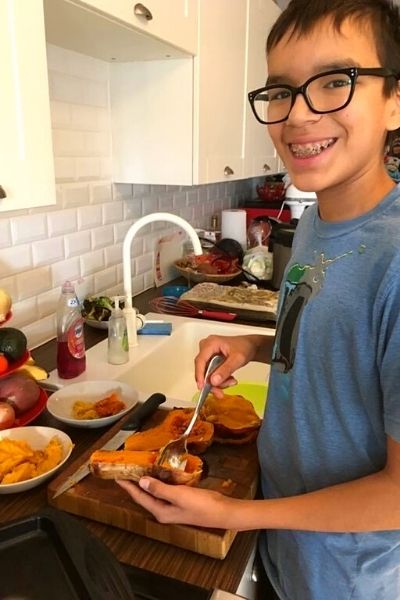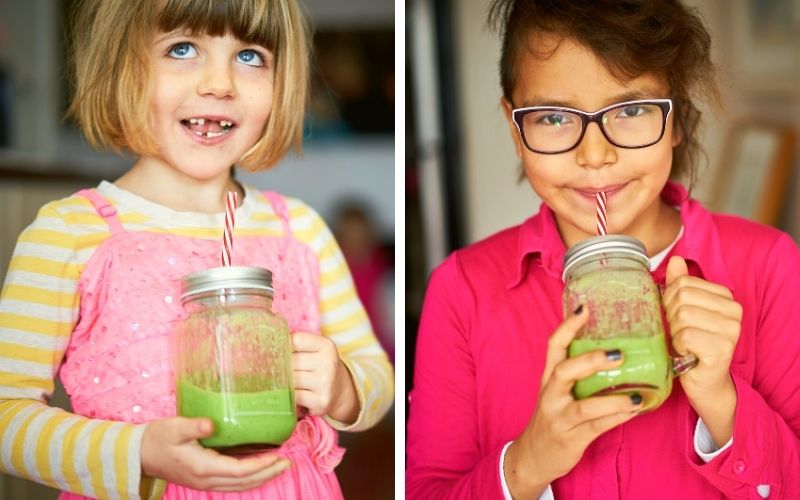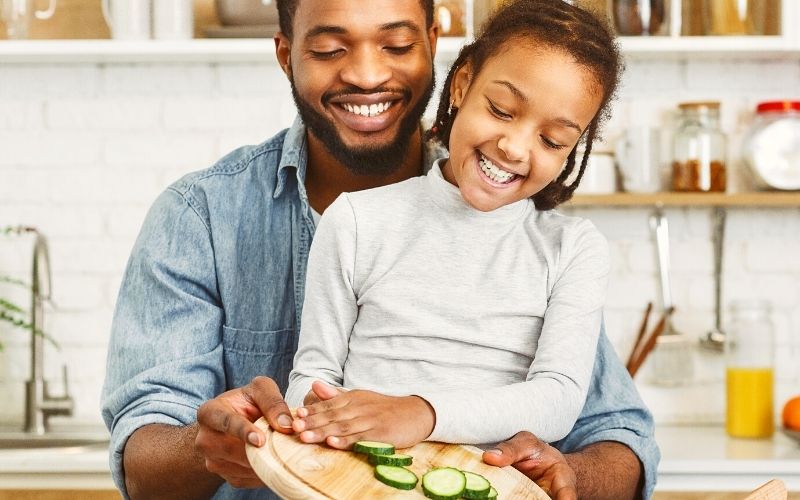Teaching kids to cook is a no-brainer: who doesn’t want their child to be able to prepare delicious and nutritious meals for themselves when they move out on their own? Even better, raising capable cooks means that, by the time they are tweens or teens, they can whip up dinner for the whole family.
But for many parents, like me, the prospect of having kids’ “help” in the kitchen can be a source of mild dread. Meal times often are stressful. When knives and high heat meet at speed during the witching hour, getting a little set of hands involved might seem dangerous. Add a second (or third, or fourth…) child who also wants to help (with the exact same task) and the scene risks dissolving into a messy fight. How should we go about teaching kids to cook so we don’t lose our minds (or fingers)?
When I first heard Dr. Pamela Fergusson talk about the “internship method” she used to grow her kids’ kitchen skills, a light bulb went on. I had to ask her how she did it. (We had a conversation about it and I transcribed the gist of it; she reviewed and edited the transcript.)
Brigitte Gemme: Thank you so much for accepting to answer my questions about how you have been teaching kids to cook in your family. Your “internship” approach sounds like it could resolve a lot of issues I have personally experienced when trying to engage my kids in the kitchen. But first tell me a little bit about your family.
Dr. Pamela Fergusson, RD: I’m happy to share how we’ve done it! I am mom to four children, currently aged 18, 16, 14, and 10. We used the internship, or “Junior Chef” approach, as I sometimes like to call it, when the big kids were a little younger – starting around 8 to 10 years old.

BG: I love the “Junior Chef” idea. Tell me more.
Dr. P: I rolled out the internships as a sort of work experience. One at a time, for a period of about one month, each child was my assistant in the kitchen. I took a professionalized approach to it, as if they were a junior colleague. I broke down the weeks into different themes and skills, and they spent just a few minutes in the kitchen most days, so it was not overwhelming. At the end, their “capstone” activity was to be in charge of preparing a full meal for the whole family. We made a big deal of it. They also got to choose an activity to do together as a reward for their hard work.
BG: What a thoughtful approach! I’d like to know about the themes you focused on.
Dr. P: At the beginning, we focused on basics and standards, in particular hygiene and food safety. Then we practiced safety around hot appliances and sharp knives. Basic knife skills were really important. The second week we focused on reading and following recipes, and also measuring ingredients with cups, spoons, and scale. Mixing and baking tasks are great for practice at that stage. Then we covered various cooking methods. Finally, we also went over meal planning and shopping.
BG: What did you find to be the key to the success of the internships?
Dr. P: Overemphasizing praise was important throughout the process, including highlighting how the “intern” contributed to each family meal, and recognizing their effort and learning. There are a lot of opportunities for mistakes and messes when kids learn how to cook, but I really wanted them to experience cooking as a source of satisfaction and pride.
BG: As their cooking skills improved, did their eating patterns change too?
Dr. P: Learning to cook goes a long toward better understanding food and building a vocabulary around it. I found that, through the process, they increased their food literacy. They were able to express their likes and dislikes with more clarity, and speak better about how they perceived the food. They were less likely to feel frustrated about the meals that I cooked, and more open to testing new things. That was definitively a positive ripple effect.

BG: How much cooking do they do now?
Dr. P: After the internship was concluded for each child, I made it a more regular habit of calling on them to help with meal preparation on a regular basis. They were more capable and independent, with real skills, so it actually helped me! Right now, they each cook dinner every two weeks or so. On Fridays, when I prepare my meal plan and shopping list for the following week, I make sure to ask them for their input so they can add ingredients and foods they will need.
BG: Do you have any extra tips you’d like to give to parents who are tempted to try this method to teach kids to cook?
Dr. P: You have to understand that, at first, having kids in the kitchen, helping, will not save you time. It’s really an investment for the future. Something I found particularly useful with the internship approach was that I had a plan, sort of a basic curriculum, and I prepared ahead of time by setting up the skill to be taught so that the kids would find it approachable. Focusing on one skill at a time, especially at the beginning, was really important. For example, that might mean pre-measuring ingredients so they can focus on the mixing. At first, their involvement can be short, like 5 to 10 minutes. Then it can increase a bit as they build stamina and become more skilled.
BG: Thank you Pamela for generously sharing your approach to teaching kids to cook with me and my readers! I am planning on getting started with my own kids in the coming few months – stay tuned for an update!
 Dr. Pamela Fergusson is a registered dietitian with a PhD in nutrition and over 15 years of experience with changing lives through better nutrition. She has worked as a lecturer in the UK and Canada, and works in private practice in British Columbia, Canada. She has been vegan for over 7 years previously a vegetarian for many years. You can learn more about working with her on her web site and make sure to follow her on Instagram and Facebook for useful and compassionate nutrition insight.
Dr. Pamela Fergusson is a registered dietitian with a PhD in nutrition and over 15 years of experience with changing lives through better nutrition. She has worked as a lecturer in the UK and Canada, and works in private practice in British Columbia, Canada. She has been vegan for over 7 years previously a vegetarian for many years. You can learn more about working with her on her web site and make sure to follow her on Instagram and Facebook for useful and compassionate nutrition insight.





Those are some great ideas. Although my kids are grown, we have some great-nieces and nephews that will soon be ready to take on kitchen tasks. I am looking forward to trying these methods.
Thanks Gary, let me know how it goes!
My boys are ages 11, 12, and 15. For the last three years they have rotated through the kitchen on a monthly basis. At first I did the sous chef work for them while they compiled the recipes. Now we often cook parallel with me making one recipe while they do another. We ran across a cooking video once that called measuring spoons TIBS and TISP so that’s how they recognize it. They all have different recipes they enjoy and consider themselves to be specialists in, created without an actual recipe. My 11 yr old makes marinara sauce from scratch and likes making pizza (because he gets to beat the dough). This marinara cooks for a few hours and becomes incredibly rich and flavorful. He recently showed his “girlfriend” how to make it and that was fun to watch. The 12 yr old loves to make tacos and is an expert in guacomole. The 15 yr old has been making ramen from scratch for a long time. They all have their strengths, but uniquely the youngest has pretty severe ADHD and does best with several recipes going at once. We put each recipe on a different counter so he can keep the ingredients organized. We have thought about making a blog, but haven’t as of yet. Three nights a week, my husband and I work overnight and the kids are on their own for dinner and fare pretty well with their food, prepping ahead of time, or planning their steps and walking to the grocery store to buy their ingredients. If you have any questions, please feel free to contact me.
This is absolutely wonderful, Jen, thank you for sharing your inspiring model! Lots to look forward to for me.